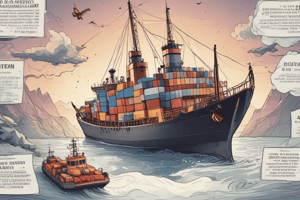Podcast
Questions and Answers
Risk indicators are subjective measures that provide early warning signs of potential risks.
Risk indicators are subjective measures that provide early warning signs of potential risks.
False (B)
SWOT analysis assesses the internal Weaknesses and external Opportunities of an organization.
SWOT analysis assesses the internal Weaknesses and external Opportunities of an organization.
False (B)
One of the primary techniques used in the SIRA process is benchmarking sessions.
One of the primary techniques used in the SIRA process is benchmarking sessions.
False (B)
Scenario analysis helps organizations prepare for certain future events.
Scenario analysis helps organizations prepare for certain future events.
Root Cause Analysis is a technique used to identify the symptoms of a problem.
Root Cause Analysis is a technique used to identify the symptoms of a problem.
Interviews and surveys are used to analyze large amounts of data and identify patterns and trends.
Interviews and surveys are used to analyze large amounts of data and identify patterns and trends.
The '5 Whys' method is a type of scenario analysis technique.
The '5 Whys' method is a type of scenario analysis technique.
Brainstorming sessions are typically structured with no specific discussion points to encourage creative thinking.
Brainstorming sessions are typically structured with no specific discussion points to encourage creative thinking.
The SIRA process uses a limited range of tools and techniques to identify and assess risk.
The SIRA process uses a limited range of tools and techniques to identify and assess risk.
The fraud prevention department notices a 20% increase in questionable transactions over the last two months.
The fraud prevention department notices a 20% increase in questionable transactions over the last two months.
Data analysis is used to generate a wide range of ideas about potential risks.
Data analysis is used to generate a wide range of ideas about potential risks.
The bank simplified its online application process to reduce the number of new customers.
The bank simplified its online application process to reduce the number of new customers.
Surveys can only be conducted one-on-one in the SIRA process.
Surveys can only be conducted one-on-one in the SIRA process.
The root cause of the problem is the insufficient balance between increasing the customer base and maintaining strict anti-money laundering controls.
The root cause of the problem is the insufficient balance between increasing the customer base and maintaining strict anti-money laundering controls.
The action plan includes reducing the number of new customers to prevent money laundering activity.
The action plan includes reducing the number of new customers to prevent money laundering activity.
The 'Fishbone' diagram is a type of scenario analysis technique.
The 'Fishbone' diagram is a type of scenario analysis technique.
Study Notes
Tools and Techniques in SIRA Process
- Effective risk identification and assessment rely on the use of various tools and techniques to develop a comprehensive understanding of an organization's risk landscape.
Brainstorming Sessions
- Brainstorming sessions involve teams from different departments and areas of expertise exchanging ideas and experiences about potential risks.
- These sessions can be structured around specific discussion points or open-ended to encourage creative thinking.
- Brainstorming sessions generate a wide range of ideas and help identify risks that may otherwise be overlooked.
Interviews and Surveys
- Interviews and surveys provide detailed insights and opinions about risk by asking standardized questions to individuals inside and sometimes outside the organization.
- These can be conducted one-on-one or through digital surveys, allowing for in-depth information on specific areas and anonymous responses to promote openness and honesty.
Data Analysis
- Data analysis involves using statistical tools and algorithms to analyze large amounts of data and identify patterns and trends that may indicate potential risks.
- This provides objective, quantitative insights and helps identify risks that are not readily observable.
Risk Indicators
- Risk indicators are specific measures that provide early warning signals of potential risks, such as financial ratios, performance indicators, or market indicators.
- Developing and monitoring these indicators allows organizations to respond proactively to changes and identify potential risks early.
SWOT Analysis
- SWOT analysis assesses an organization's internal Strengths and Weaknesses, as well as external Opportunities and Threats.
- This provides a structured overview of the factors that can affect the organization, helping prioritize actions and make strategic decisions.
Scenario Analysis
- Scenario analysis helps organizations understand how different future scenarios may affect the organization.
- By developing detailed stories of how the future may unfold, organizations can prepare for uncertain future events and develop flexible strategies.
Root Cause Analysis
- Root Cause Analysis aims to identify the root causes of identified risks using techniques like the "5 Whys" or "Fishbone" diagrams.
- This helps to effectively address problems by focusing on the root cause rather than symptoms.
"5 Whys" Method of Root Cause Analysis
- The "5 Whys" method involves asking "why" five times to drill down to the root cause of a problem.
- This method is used to identify the underlying causes of risks, as demonstrated in the example of a bank detecting a significant increase in questionable transactions indicating possible money laundering activity.
Studying That Suits You
Use AI to generate personalized quizzes and flashcards to suit your learning preferences.
Description
Learn about the importance of using various tools and techniques in the SIRA process for effective risk identification and assessment. Discover how brainstorming sessions and other methods help organizations make informed decisions and develop risk management strategies.




